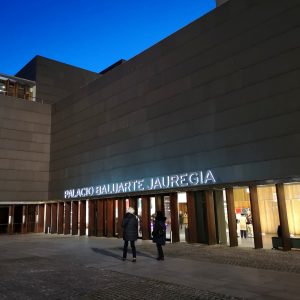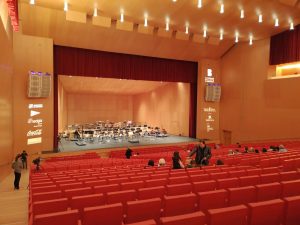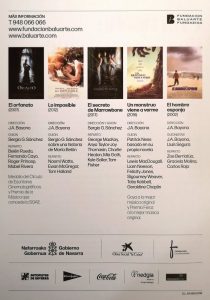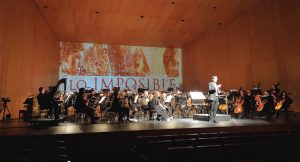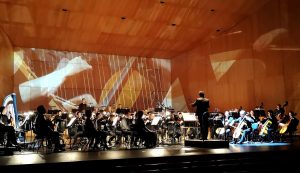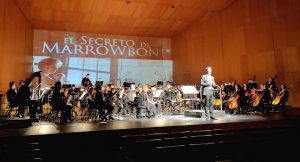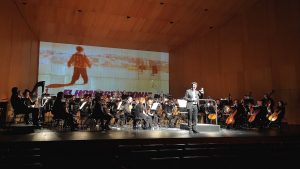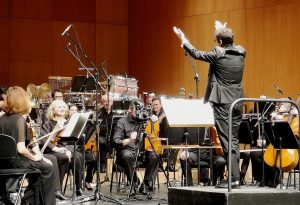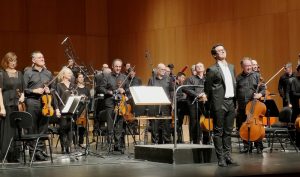Fernando Velázquez and the OSN – Concert ‘A Night of Music and Cinema’
On Friday, March 8, the Orquesta Sinfónica de Navarra – Navarre Symphony Orchestra (OSN) conducted by Fernando Velázquez offered a concert in the Baluarte theatre of Pamplona (Navarre, Spain) entitled ‘A Night of Music and Cinema’, with a program dedicated to the music of Velázquez in the movies of J.A. Bayona (read more).
Gorka Oteiza attended the concert, and leaves us this detailed article about that evening for SoundTrackFest.
THE CONCERT
Pamplona (Navarre, Spain) was the place where the concert entitled ‘A Night of Music and Cinema’ was celebrated on March 8, which lasted almost an hour and a half, and reviewed the most important titles that united the career of composer Fernando Velázquez and movie director Juan Antonio Bayona.
The concert, performed by the Orquesta Sinfónica de Navarra – Navarre Symphony Orchestra (OSN) and conducted by Velázquez, was held in the Baluarte venue, a building of modern and very functional character, with the main auditorium with capacity for 1000 people (not counting the upper level), being approximately 3/4 full.
As soon as we entered the auditorium, we could see the stage at the end, occupied by the chairs and music stands for the orchestra, as well as the percussion/piano/harp/celesta instruments in their usual locations, in a concert that was not going to have a choir, as it was indicated on the printed program.
Note that every suite was a single piece that was performed from beginning to end, and not as in other occasions several individual pieces performed in a row, with brief breaks between them. Due to the great narrative structure of all these suites, none of them felt long or heavy, but quite the opposite. During the 18 or 19 minutes of ‘The Orphanage’, ‘The Impossible’, or ‘A monster calls’, we could see how the film was being musically summarized, showcasing a perfect story in the suite, but without images.
And when I say without images, I say it in a figurative way, since there was image projection during the concert; still photos from the movies, very well interspersed with the live performance of the musicians, the orchestra and Velázquez conducting, but no synchronized videos were projected. It is a good idea to do it this way, since the videos distract greatly the attention from the real protagonist: the music.
Indicate that the projection was made on the three walls of the stage of the theater (two side walls and the bottom wall), which had a wooden surface and in which the detail of what was being shown was not very clear, but that made the projections blend and not distract in excess from the music, simply providing an additional color note, aided by the reinforcement of the side lights that illuminated at specific moments during the pieces.
The concert was amplified, to equalize the balance of the instruments of the orchestra, and to make the final sound homogeneous.
But let’s leave “technical details” aside and let’s talk about the concert, which starts almost punctually, 5 minutes after 20h, with the Orquesta Sinfónica de Navarra – Navarre Symphony Orchestra (OSN) entering the stage followed by the conductor and composer, Fernando Velázquez, receiving both a great applause from the audience. Before starting with the first suite, Velázquez explains briefly the format that the concert will have, stating that before each piece he will give a brief explanation about its history and its meaning, so that later on when we listen to the piece, we can understand a little bit better the work behind it and its meaning.
Thus, we begin the evening with a suite of The Orphanage, with its main theme present in multiple parts, a suite that alternates between moments of tension, anguish, and horror, having many twists, interspersed with moments of calm, until it arrives to a great conclusion at the end of its 19 minutes, where, as Velázquez had previously commented, the main theme goes down creating uncertainty during the whole suite, to find an opening at the end.
A great applause from the audience follows the end of the piece, and Velázquez takes the microphone again to introduce the next suite, The Impossible, explaining how according to the style of the “gamelan” music of Southeast Asia, the main theme follows a pentatonic scale, thus helping to locate the soundtrack in Asia in a subtle way.
The suite, which I already had the opportunity to listen to previously in other concerts, is a real delight, and it starts with the percussion section “in crescendo”, creating tension and restlessness, and thus emulating the actions of that terrifying wave of the tsunami, which grows until it reaches the coast and wipes out everything. Throughout this suite, the lights effects accompanied the music in several moments, simulating water patterns in a very appropriate way. I have to highlight the main moment of the suite, in which the cello solo conveys all the emotion and tension of a separated family that tries to meet again, giving with its sweet sound a halo of hope, confronting so much chaos and adversity. A family that is looking for a reunion and for a happy ending, which arrives in the last moments, and ends musically in a similar way as it had begun, in a soft, slow, and quiet way, diminishing its intensity, like water that returns to its natural calm state. Wonderful!!
Great applause gives way again to the explanations of the composer, who begins praising the Orquesta Sinfónica de Navarra – Navarre Symphony Orchestra (OSN) and their work and quality, with which he recorded the soundtrack of The Invisible Guardian in 2017, and with which he indicates that wants to make new recordings soon. Then he talks about the movie Marrowbone, which is not directed by Juan Antonio Bayona, but has Sergio G. Sánchez as director and screenwriter, who had been a scriptwriter of ‘The Impossible’ and ‘The Orphanage’, and so he asks us to allow him the license that has taken to include this piece in the program.
The baton raises and the music starts, and being this the shortest suite of the whole concert, it is also one of the most heartfelt suites, since it conveys and reflects the suffering of a family that wants to leave its past behind, but even if they try it, things don’t go as expected, reflecting the music the tensions and the sufferings, but giving moments of respite when both the harp and the celesta come into action.
It is already 21h, an hour of concert has passed, and I must admit that so far time has gone really fast! Again, microphone in hand, Velázquez comments on this occasion the music of A monster calls, the soundtrack that gave him a Goya Award. It was his third nomination, and it seems that finally the third time was the definitive one. Velázquez comments on how they joked at home with the previous two nominations, saying “Keep calm Fernando… we don’t need a Goya, if we already have a Velázquez!”. But finally, it arrived!
Fernando Velázquez also tells us a secret… The first collaboration he had with Juan Antonio Bayona was in 2002 with the short film El hombre esponja (curiously, starring Zoe Berriatúa, known in SoundTrackFest for his movie ‘En las Estrellas / Up among the Stars’ where we interviewed him – read article). Well, Velázquez tells us how the main themes of El hombre esponja and of A monster calls are the same, but slightly changing the rhythm and accents of the music, and asks us to pay close attention to the next two suites. This revelation is quite surprising for the audience (and for me), but as both suites are going next in the program, we will soon be able to see if this is true.
A complete and very narrative suite of A monster calls starts, a suite that lasts 18 minutes, where the main theme appears on multiple occasions and transports us to the different and difficult moments that the protagonist has to bear during the film, fighting with his inner demons. A very intense suite, varied, and very well performed by the orchestra. It really deserved the Goya Award in 2017 (for the 2016 film).
And when we are about to reach the end of the concert, Velázquez gives us the last explanation of the night, where he says that he met Juan Antonio Bayona through director Koldo Serra, his friend and neighbor, who curiously today, March 8, premieres in Spain his latest film 70 BinLadens (and you can read a special article about it in the following link – read article), and tell us how this presentation led to his first joint collaboration with Bayona in the short film El hombre esponja.
Leaving the microphone and taking the baton, the Orquesta Sinfónica de Navarra – Navarre Symphony Orchestra (OSN) under the instructions of Fernando Velázquez start the last suite, El hombre esponja, which begins softly at the piano, to immediately pick up the melody of the main theme, where we can clearly see that it is indeed the same as in the previous suite, but changing the accents and the tempos. The suite continues to advance, and little by little starts picking strength and rhythm, reaching a heroic final part, where brass section takes prominence and ends up providing a great adrenaline boost.
It is already 21:30h, the concert is over, and the audience applauds with enthusiasm and excitement; and it’s a well-deserved ovation, since we have been able to listen and enjoy to a very good concert, beautifully performed by the Orquesta Sinfónica de Navarra – Navarre Symphony Orchestra (OSN), and perfectly conducted by Fernando Velázquez.
Velázquez gives us signs saying that the night is over, but the audience responds by cheering and applauding louder, and despite leaving the stage to return on a second occasion with the intention of leaving it definitively, he has to come out once more to please the audience, and offer a brief encore, which clearly both him and orchestra were not expecting.
The encore was the final minute of the suite of El hombre esponja, the epic and heroic part, with which Fernando Velázquez and the orchestra said goodbye to the audience, this time, definitely.
In short, a concert of almost an hour and a half without intermission, beautifully performed and very well conducted, and with a delicious selection of music, with long suites of each film.
As an anecdote, note that after the explanation that Velázquez gave, it was curious to see how the theme of A monster calls (2016) and the theme of El hombre esponja (2002) (suites that were rightly programmed one after another), were almost identical, but changing slightly the rhythm and the accents of the music.
And so, after having enjoyed a great concert, I leave the venue humming the theme of ‘El hombre esponja’, with a curious idea in my mind… Fernando Velázquez had already won the Goya in 2002, 14 years before he got it for ‘A Monster Calls’… but he was not yet aware of it!
Article by Gorka Oteiza



